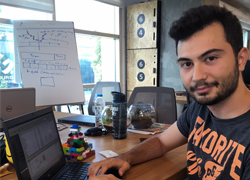Working with a robot
23 August 2018
Robotics and Artificial Intelligence (AI) technology are rapidly changing our world. What does this mean for our work? What tasks do we already leave to robots? We asked three employees from across the business who already work with some kind of a ‘robot’.

Name: Gurer Kural.
Age: 24.
Country: Turkey.
Role: Business developer in the operations department.
Joined ING in? July 2017.
Study: Industrial engineer with finance minor. This is my first real job.
1. What is your current job?
I work on robotics and AI as a business developer.
2. How do you use robots or automation?
With robotics we reduce the time employees spend on things that do not need people’s intelligence. We’ve just started with some AI projects, for example a project predicting the minimal amount of cash we need to hold in branches. We’re also helping HR recruit people for call centres and IT who best fit best the Orange Code.
3. What set of skills do you need for your job?
Knowing how to read data and how to apply it. I had no experience when I came here, but neither did anyone else at ING (with robotics). The project is growing and I am growing along with it.
4. What’s the biggest challenge in your work?
Finding the right data is the biggest problem, because 70 to 80 percent of our job is crushing the data. Being able to look at data and give it meaning is a bit like learning English, a new language and a total must in the future.
5. Do you think you’re a banker?
Yes. I’m a banker, because I work with customers, branches and financial data.

Name: Celal Aslan.
Age: 27.
Nationality: Dutch and Turkish.
Role: Account management for corporate clients (Wholesale Banking).
Joined ING in: 2014
1. What is your current job?
We work in small service teams (eight people per team), answering questions from international clients. Most communication is done by email, we get about 120 emails a day. The questions are mostly about day-to-day stuff like how to open an account in the Netherlands or any other ING branch or on international payments.
2. How do you use robots or automation?
We’ve been using the chatbot Bill since 2016 to find the information we need to give a correct answer. The most frequently asked question is what the “cut off” time is for international payments in different currencies. Bill knows this within seconds, while it would take me minutes to search the answer online.
3. What set of skills do you need for your job?
Eager to learn, planning and organisation, being stress resistant, result-oriented, flexible and customer friendly.
4. What’s the biggest challenge in your work?
That we depend on the back office and other branches to retrieve our information. We’re not always able to give the answers as quickly as we would like to. But we’re getting there. Soon Bill will know much more. I can’t wait.
5. Do you think you’re a banker?
Yes. I ‘ve been working at ING for several years now, and have had many interactions with clients and stakeholders. I’ve seen plenty of this company and therefore I definitely consider myself a banker.

Name: Leonardo Lamia.
Age: 48.
Country: Belgium.
Role: Safe Business Officer, Retail clients.
Joined ING in? September 1992
Study: Marketing.
1. What is your current job?
To make sure that the requirements of the law and of the Financial Economic Crime (FEC) policy of ING are followed by the business. We identify non-financial risks to ensure the correct onboarding and review of clients.
2. How do you use robots or automation?
We have an automated system that does basic client reviews for us. Checking whether they still have the same address and employment. Previously, this was all done through sending letters, now the system calls the clients on their mobile. The callbot can even personalize each client call at low marginal cost. It’s super-fast, and clients respond well. This year, we’ll review 50,000 clients this way. We also have a system preparing exit-letters to clients we need to stop doing business with.
3. What set of skills do you need for your job?
I know I’m not the youngest, luckily age does not matter with this new technology. A good knowledge of the business, being analytical and open for change are much more important.
4. What’s the biggest challenge in your work?
Some processes are too complex and take too much time. In the end, robots will help us improve the customer experience and relationship, while reaching more clients in a shorter amount of time. This way we don’t unnecessary lose clients.
5. Do you think you’re a banker?
Yes, even if I do not deal with financial matters, I consider myself as a banker. The Know Your Customer (KYC) aspect is a crucial part of a banker’s job.



